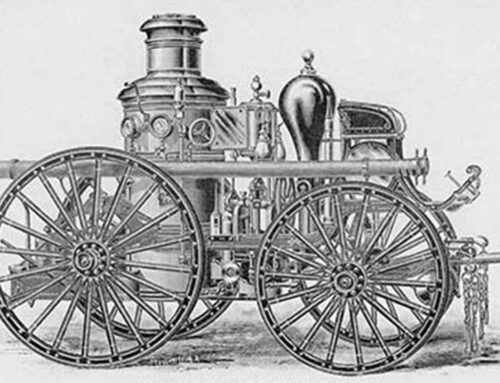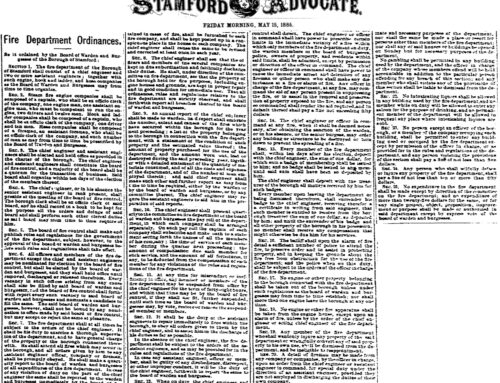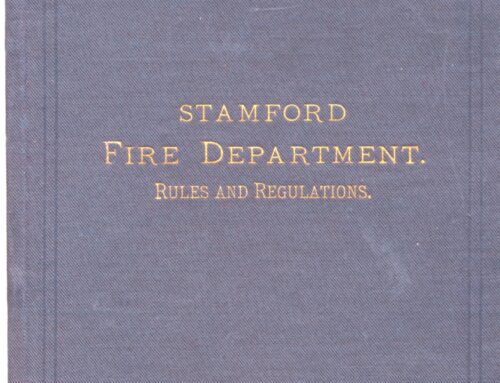As published in the Daily Advocate (Published as STAMFORD ADVOCATE) on January 10, 1959, pages 1 and 8
Freight Jumps Track, Crashes Mail train
Four cars plunge into road after wreck at bridge
All tracks tied up in wreckage – strewn area; fire results
Eaighteen cars of a westbound freight train jumped the express track at the Atlantic Street bridge, 200 yards east of the Stamford railroad station this morning at 530, slammed against two cars of an empty mail train on another track, and burst into flames.
No one was injured in the wreck, despite the fact that the cars were strewn across the four tracks, and four landed on South Frontage Road, 30 feet off the embankment.
Tracks ripped up
The collision between the 20 cars ripped up tracks within a 100 yard area. Freight cars were piled up – one on the other. High power wires were ripped away by the impact, and two towers ripped down.
Cars on both trains burned fiercely, and even though Fire Chief Thomas F Richardson declared the blaze under control at 730, flames were still shooting from some of the cars.
Burning fiercely during the early morning hours were cars that contained shipments of new tires. Other freight cars carried toys, canned goods, newsprint and general goods.
Car demolished
The mail trains rear car – the only passenger coach – was completely demolished, and hung partially down the embankment leading to South Frontage Rd. — being held in place by freight trains on top of it.
Conductor Michael Halcheck of Hempstead, Long Island, and flagman Harry Moffatt of Newark, New Jersey, who normally ride in the coach, escaped almost certain death by riding in the engine because of a defective heater in the coach.
With no heat in the coach, and the temperature at 13°, the two railroad men decided a cold car was no place to be, and went up to the engine — shortly before the mail train reached Stamford.
Halted at station
Railroad superintendent Keith Young of the main office informed the Advocate that the mail train, “Number 95,” making a Boston to New York run, had come to a halt at the station, when the freight cars at the rear of the next track – Track One – whipped into it.
The freight, known as the “M – 7 Bullet,” was heading toward New York from Worcester, Massachusetts, at a rate of about 50 mph, when the derailment occurred, according to Young.
In his early estimate, Young voiced the opinion that it would be 24 hours before the rails could be cleared for traffic.
Track clearing
Later, Stamford stationmaster Frank Moran, said that possibly the first tracks that could be cleared, would be “Tracks 2 and 4.” At 9:10, he said that tool trains were on the way from Oak Point Yards, Bronx, New York and New Haven.
As flames were still billowing from the freight cars, Moran stated he would be unable to estimate how long it would take to clear “at least one track”.
Passenger shuttle
By 9 AM, arrangements had been made to shuttle railroad passengers by bus from the South Norwalk station to the Greenwich station. Buses were also engaged to pick up commuters along the stations of the New Canaan line, take them to Stanford, and shuttle them and passengers at the Stamford station to Greenwich. Locals from Greenwich to New York and New York to Greenwich, were transporting passengers shortly after 9:15.
Three freight cars fell 30 feet into S. Frontage Rd. with an empty oil car, and burst into flame. Luckily there was no vehicular traffic on this busy roadway at that hour.
Tracks Blocked
Other cars were piled crazy – quilt fashion across the right of way, blocking off all four mainline tracks on the New Canaan rails.
Power lines were strewn across the tracks in all directions, tracks ripped up and broken lines were scattered along S. Frontage Rd., from the bridge to the railroad station, and along a portions of Manhattan Street, on the other side of the railroad embankment.
Fire Alarms
Deputy Chief Harold J Fisher who responded to the call with Central, South end and Westside cruise, ordered a second alarm shortly after arriving at the scene. When chief Thomas F Richardson responded with East side fireman and apparatus, it was determined that the extra company was not needed, and they were sent back to their station.
Using aerial truck ladders to work hose down on the blazing cars, firemen also worked hose from S. Frontage Rd., Manhattan Street, and the tracks proper.
Power was caught off on all mainline tracks immediately after the wreck. Most of the broken wires on the adjacent streets were “alive” until the electricity was turned off.
Grandstand View
The embankment of the adjacent Turnpike, some 30 yards from the electric street bridge, afforded spectators a natural grandstand above the fire trucks.
Travelers and truckers halted along the Turnpike, leaving several hundred cars lined up on both sides of the road.
When the freight train snapped off from the rear of the diesel, it gave the diesel such a push it continued on for several hundred yards before coming to a halt, according to Young.
Fighting the blaze in 13° temperature, firemen, for time were worried about tth tank cars — not knowing whether they contained explosive fluids.
Tank Cars Empty
Able to get close to the tank cars by 7:30, Chief Richardson found that both were empty. Neither had red labels, which signify flammable or explosive materials, the Chief said.
Early on the scene, Police Chief Joseph W Kinsella ordered traffic cut off in the S. Frontage Rd., Atlantic St., Manhattan Street areas, and rerouted. He also called on Capt. Harold J Herbert to order out 30 off-duty policemen, to handle the rerouting, and keep the curious “a good distance away” from the burning wreckage.
Move Saved Lives
Questioned by a reporter at the scene, Conductor Halcheck, of the empty mail train stated that he and Moffatt had received permission to ride up front.
If it hadn’t been for the change, he said, “I wouldn’t be here now.”
The area under the Atlantic Street bridge resembled an ice-skating rink, due to the thousands of gallons of water being poured out in the subzero temperature.
Signals Affected
Railroad crossing signals on the New Haven line went completely askew when the power lines were not down. Not only were the crossings unmanned, the cars were backed up for considerable distances — motorists being confused by the unusual situation.
The only injury reported in connection with the wreck occurred when Stamford Conductor Frank J Larkin, 50, of 140 Fleet St., received a leg fracture when he tripped over a fallen wire as he was running to the scene of the wreck.
He was taken to St. Josephs Hospital for treatment.
At 1o this morning, Mr Robert Kernan, Assistant Chief of the New Haven railroads Information Office, predicted that no tracks would be cleared until “early Sunday morning.”
He stated that “track two” and “four” would be the first to be cleared of wreckage and repaired. At least 25 yards of track need repair, McKernan estimated.
Crew Arrives
The wrecker train dispatched from New York arrived in Greenwich at 10. The crew will get to work as soon as the fire is out.
Chief Richardson pointed out that a fire and burning tires take some time to extinguish. “Even if we think it’s out, the blaze may flare up again”, he told The Advocate.
The last train wreck of such disastrous proportions occurred August 26, 1956 at the Canal Street bridge. The derailment of several freight cars on that date were blamed by railroad men on a broken Journal on a Pittsburgh and Lake Erie freight.
The railroad at that time, estimated the cost of the derailment – 14 cars of a 70 car train – at $70,000.
Probe of Cause
McKernan, informing The Advocate at 1025, that “the accident would have to be investigated before exact cause of the wreck would be determined.”
He said that personnel on both trains would have to be questioned, and a check made on the cars and tracks. “This could take days or weeks” he said.
Location on Present Day Map
Photo Collection




















